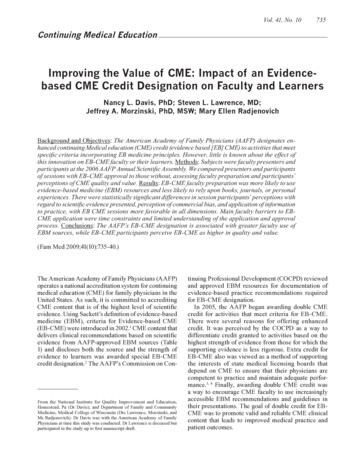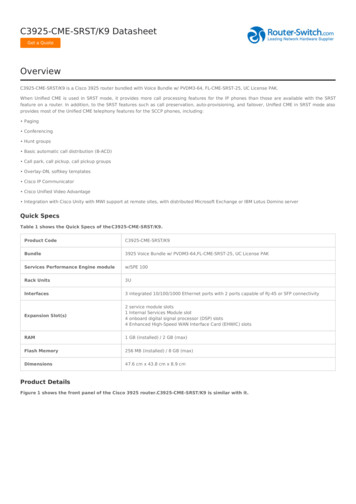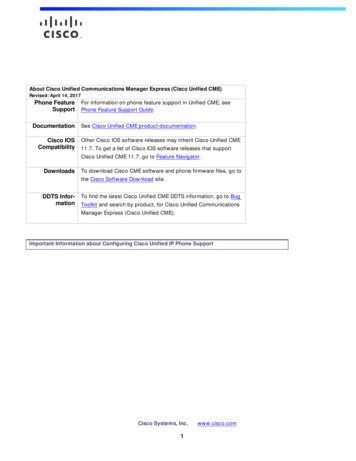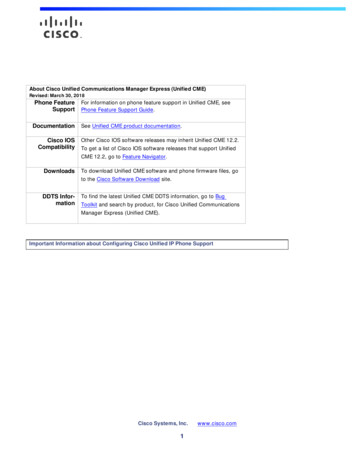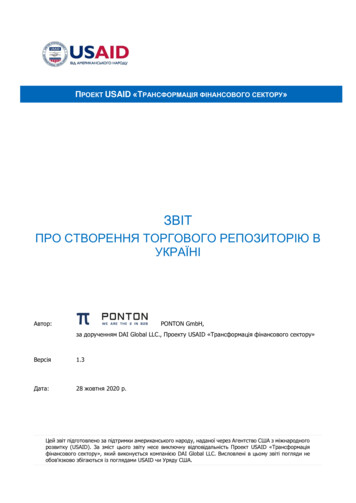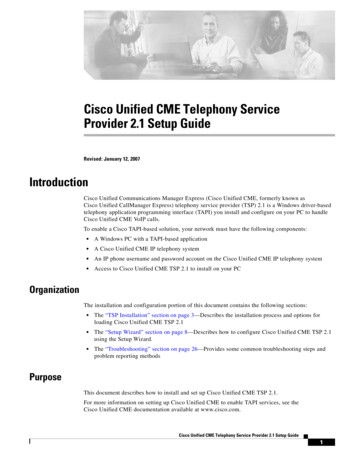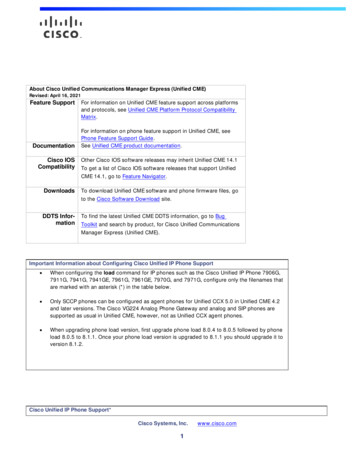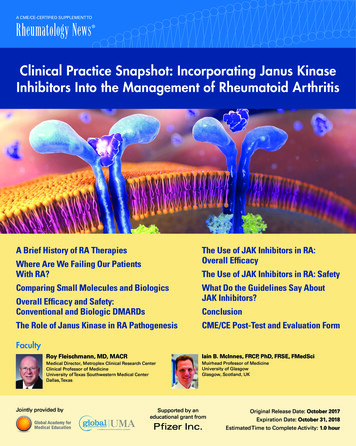
Transcription
A CME/CE-CERTIFIED SUPPLEMENT TORheumatology News Clinical Practice Snapshot: Incorporating Janus KinaseInhibitors Into the Management of Rheumatoid ArthritisA Brief History of RA TherapiesThe Use of JAK Inhibitors in RA:Overall EfficacyWhere Are We Failing Our PatientsWith RA?The Use of JAK Inhibitors in RA: SafetyComparing Small Molecules and BiologicsOverall Efficacy and Safety:Conventional and Biologic DMARDsWhat Do the Guidelines Say AboutJAK Inhibitors?ConclusionThe Role of Janus Kinase in RA PathogenesisCME/CE Post-Test and Evaluation FormFacultyRoy Fleischmann, MD, MACRIain B. McInnes, FRCP, PhD, FRSE, FMedSciMedical Director, Metroplex Clinical Research CenterClinical Professor of MedicineUniversity of Texas Southwestern Medical CenterDallas, TexasMuirhead Professor of MedicineUniversity of GlasgowGlasgow, Scotland, UKJointly provided bySupported by aneducational grant fromPfizer Inc.Original Release Date: October 2017Expiration Date: October 31, 2018Estimated Time to Complete Activity: 1.0 hour
Method of ParticipationParticipants should read the CME/CE information, review the activityin its entirety, and complete the online post-test and evaluation. Uponcompleting this activity as designed and achieving a passing score onthe post-test, you will be directed to a Web page that will allow you toreceive your certificate of credit via e-mail or you may print it out atthat time.Target AudienceTerm of OfferingThis activity was released on October 1, 2017, and is valid for 1 year.Requests for credit must be made no later than October 31, 2018.Global Education Group Contact InformationFor information about the accreditation of this activity, please contactGlobal Education Group at 303-395-1782 or inquire@globaleducationgroup.com.This interactive, online activity is intended for rheumatologists,internal medicine physicians with a secondary specialty in rheumatology, physician assistants (PAs), nurse practitioners (NPs), andnurses in rheumatology, and other clinicians who treat patients withrheumatic diseases.Instructions for Obtaining CreditLearning ObjectivesFee Information and Refund/Cancellation PolicyAfter completing this activity, participants should be better able to: Design optimal treatment strategies for patients with rheumatoidarthritis (RA) to improve remission rates and/or minimize levelsof disease Recognize the role that Janus kinase (JAK) plays in the pathogenesis of RA and the corresponding impact of JAK inhibition in themanagement of RA Discuss treatment options for RA, including the use of JAK inhibitors,as reflected in current practice guidelinesPhysician Accreditation StatementThis activity has been planned and implemented in accordance with theaccreditation requirements and policies of the Accreditation Council forContinuing Medical Education (ACCME) through the joint providershipof Global Education Group and Global Academy for Medical Education.Global Education Group is accredited by the ACCME to providecontinuing medical education for physicians.Physician Credit DesignationGlobal Education Group designates this enduring material for a maximumof 1.0 AMA PRA Category 1 Credits . Physicians should claim only thecredit commensurate with the extent of their participation in the activity.Nursing Continuing EducationGlobal Education Group is accredited as a provider of continuing nursingeducation by the American Nurses Credentialing Center’s Commissionon Accreditation.This educational activity for 1.0 contact hour is provided by GlobalEducation Group. Nurses should claim only the credit commensuratewith the extent of their participation in the activity.Program OverviewCurrent guidelines for the management of rheumatoid arthritis (RA)address the concern that many patients fail to respond, or loseresponse, to first-line therapy with disease-modifying antirheumaticdrugs (DMARDs). Lack of understanding about the optimal use of available RA therapies—including combination therapy or switching to otherdrugs within a class or in a different class—means that many patientsmay fail to achieve remission (the ideal goal) or minimal levels of diseaseactivity. Clinicians who are unaware of current practice guidelines maynot be providing optimal management for their patients with RA. Inaddition, clinicians should be aware of data concerning the safety andefficacy of newly available drugs so as to ensure selection of optimaltherapies for patients with RA. Knowledge of agents that have novelmechanisms of action, including Janus kinase inhibitors, can improveclinicians’ confidence when switching therapies in patients who havesuboptimal response despite appropriate use of DMARD therapies.Joint Providership StatementThis activity is jointly provided by Global Education Group and GlobalAcademy for Medical Education.2In order to receive credit, participants must complete the online evaluation and post-test at the end of this activity. Participants must also scoreat least a 65% on the post-test. Statements of credit will be issued uponcompletion of the evaluation and post-test.There is no fee for this educational activity.Disclosure of Conflicts of InterestGlobal Education Group requires instructors, planners, managers, andother individuals and their spouse/life partner who are in a positionto control the content of this activity to disclose any real or apparentconflict of interest they may have as related to the content of thisactivity. All identified conflicts of interest are thoroughly vetted byGlobal Education Group for fair balance, scientific objectivity of studiesmentioned in the materials or used as the basis for content, and appropriateness of patient care recommendations.The faculty reported the following financial relationships or relationships to products or devices they or their spouse/life partner have withcommercial interests related to the content of this CME/CE activity:Name of Faculty or Presenter: Roy Fleischmann, MD, MACRReported Financial Relationship: Consultant: AbbVie, Lilly, Pfizer.Grant/Research Support: AbbVie, Lilly, Pfizer.Name of Faculty or Presenter: Iain B. McInnes, FRCP, PhD, FRSE, FMedSciReported Financial Relationship: Consultant: AbbVie; GalapagosPharma; Lilly; Pfizer. Grant/Research Support: Bristol-Myers Squibb;Janssen; Pfizer; UCB.The planners and managers reported the following financial relationships or relationships to products or devices they or their spouse/lifepartner have with commercial interests related to the content of thisCME/CE activity: Ashley Marostica, RN, MSN; Laura Gilsdorf; RonSchaumburg; Mike LoPresti; Shirley Jones, MBA; and Scott Kober allhave nothing to disclose.Disclosure of Unlabeled UseThis educational activity may contain discussion of published and/orinvestigational uses of agents that are not indicated by the US Food andDrug Administration. Global Education Group and Global Academy ofMedical Education do not recommend the use of any agent outside ofthe labeled indications.The opinions expressed in the educational activity are those of thefaculty and do not necessarily represent the views of any organization associated with this activity. Please refer to the official prescribinginformation for each product for discussion of approved indications,contraindications, and warnings.DisclaimerParticipants have an implied responsibility to use the newly acquiredinformation to enhance patient outcomes and their own professionaldevelopment. The information presented in this activity is not meant toserve as a guideline for patient management. Any procedures, medications, or other courses of diagnosis or treatment discussed in thisactivity should not be used by clinicians without evaluation of patientconditions and possible contraindications on dangers in use, reviewof any applicable manufacturer’s product information, and comparisonwith recommendations of other authorities.globalacademycme.com/rheumatology Clinical Practice Snapshot: Incorporating Janus Kinase Inhibitors Into the Management of Rheumatoid Arthritis
Clinical Practice Snapshot:Incorporating Janus KinaseInhibitors Into the Managementof Rheumatoid ArthritisA CME/CE-CERTIFIED SUPPLEMENT TORheumatology News Table of Contents4A Brief History of RA Therapies4Where Are We Failing Our Patients With RA?6Comparing Small Molecules and Biologics7Overall Efficacy and Safety:Conventional and Biologic DMARDs7The Role of Janus Kinase in RA Pathogenesis10 The Use of JAK Inhibitors in RA: Overall Efficacy13 The Use of JAK Inhibitors in RA: Safety13 What Do the Guidelines Say About JAK Inhibitors?13 Conclusion15 CME/CE Post-Test and Evaluation FormFacultyRoy Fleischmann, MD, MACRMedical Director, Metroplex Clinical Research CenterClinical Professor of MedicineUniversity of Texas Southwestern Medical CenterDallas, TexasIain B. McInnes, FRCP, PhD, FRSE, FMedSciMuirhead Professor of MedicineUniversity of GlasgowGlasgow, Scotland, UKClinical Practice Snapshot: Incorporating Janus Kinase Inhibitors Into the Management of Rheumatoid ArthritisThis continuing education supplementwas developed from interviews withthe faculty. It is the second activity inthe two-part curriculum, From Scienceto Practice: Understanding the Roleof Janus Kinase in RA Pathogenesis toAppropriately Incorporate JAK Inhibitionin RA Management. The supplementcontent was derived from the keyteaching points from the previousonline activity, which may be found gy.The faculty acknowledge the editorialassistance of Global Academy forMedical Education, LLC, andScott Kober, medical writer, in thedevelopment of this supplement.Neither the editors of RheumatologyNews nor the Editorial Advisory Boardnor the reporting staff contributed toits content. The ideas and opinionsexpressed are those of the faculty and donot necessarily reflect the views of thesupporters, Global Academy for MedicalEducation, Global Education Group, orthe Publisher.Copyright 2017 by Global Academy forMedical Education, LLC, Frontline MedicalCommunications Inc., and its Licensors. Allrights reserved. No part of this publication maybe reproduced or transmitted in any form, by anymeans, without prior written permission of thePublisher. Global Academy for Medical Education,LLC, Frontline Medical Communications,and Global Education Group will not assumeresponsibility for damages, loss, or claims of any kindarising from or related to the information containedin this publication, including any claims related tothe products, drugs, or services mentioned herein.3
This supplement explores the current shortfalls in the care of patients with rheumatoid arthritis (RA), thesimilarities and differences between small molecules and biologics, the role of Janus kinase (JAK) inhibitionin RA pathogenesis, and the current and potential future role of JAK inhibitors in the treatment of RA.A Brief History of RA TherapiesIn 1998, the US Food and Drug Administration (FDA) approvedinfliximab for the treatment of Crohn disease, marking the dawn ofthe biologic era in inflammatory diseases (Figure 1).1 A few monthslater, etanercept became the first tumor necrosis factor (TNF) inhibitorto be approved by the FDA for the treatment of RA. As the rheumatologycommunity gained a more thorough understanding of the role of cytokinesand immune system cells in RA, additional biologics were introduced thattargeted TNF, interleukin (IL) 1 and 6, and T- and B-cell function.1In parallel with the development of biologics in RA, cancer researchersdeveloped a new type of agent that blocked intercellular tyrosine kinases.The first small-molecule tyrosine kinase inhibitor (TKI) to be FDAapproved was imatinib, introduced in 2001 for patients with chronicmyelogenous leukemia. Additional TKIs for treating solid-tumorcancers soon followed.As our understanding of the role of tyrosine kinases in the development and progression of autoimmune disease grew, research into newstrategies for the treatment of RA shifted in the direction of uniquesmall molecules that could target these pathways. In 2012, tofacitinib,a JAK inhibitor, became the first small-molecule kinase inhibitor to beapproved by the FDA for the treatment of RA. A second JAK inhibitor,baricitinib, is approved for use in the European Union for the treatment of RA and was submitted to the FDA for potential approval in2016. In April 2017, however, the FDA issued a complete responseletter asking baricitinib’s manufacturer for more safety data, as well asadditional information on the most appropriate doses of the drug to beused in patients with RA. In August 2017, baricitinib’s manufacturerannounced that it would add additional data to its resubmission forpotential FDA approval in early 2018.Figure 1. Timeline of RA Research and ty Rheumatoidshown tofactorcause arthritisisolated1988MTXfortreating 1940193519301900189519411950sRA as a distinct Steroids inclinical entity the treatmentof autoimmunity199820062012Infliximab Rituximab TofacitinibforforforCrohn diseaseRARA2017BaricitinibunderFDA reviewCML chronic myelogenous leukemia; FDA US Food and Drug Administration; MTX methotrexate; RA rheumatoid arthritis.Where Are We Failing Our Patients With RA?Without question, the rheumatology community has made remarkable strides in halting the functional loss and associated damage of RA,thanks primarily to the use of biologic therapy along with refined treatment strategies. Nonetheless, as the bar keeps being raised, and bothproviders and patients expect to achieve clinical remission in manycases, further improvements are needed.Up to 35% of patients with RA do not respond adequately tobiologic therapy; less than one-third of established patients with RA4achieve clinical remission by American College of Rheumatology/European League Against Rheumatism (ACR/EULAR) remissioncriteria.2 Although the use of biologic disease-modifying antirheumatic drugs (DMARDs) in combination with methotrexate (MTX)is clearly superior to conventional synthetic disease-modifying antirheumatic drugs (csDMARDs) in alleviating symptoms of RA, manypatients continue to experience unacceptable levels of pain despite theuse of these newer agents.2 Physical and sexual functioning, as well aslevels of fatigue, also persist at an unsatisfactory level in many patientswith RA despite aggressive therapy.2,3globalacademycme.com/rheumatology Clinical Practice Snapshot: Incorporating Janus Kinase Inhibitors Into the Management of Rheumatoid Arthritis
Treat-to-target guidelines, updated in 2014, were intended to helpnarrow these treatment gaps by providing rheumatologists and patientswith clear strategies to help achieve optimal outcomes—either remission or, in cases of patients with active disease, low disease activity.4Unfortunately, the adoption of these guidelines in real-world scenarioshas lagged for several reasons5:1. Many patients with RA do not receive a csDMARD, let alone abiologic DMARD (bDMARD). Population-based studies haveshown that 35% of Medicare recipients diagnosed with RA donot fill a prescription for a csDMARD.6 Although it is possible thatsome of these patients have very mild RA (and thus may not requirecsDMARD therapy) or have contraindications to csDMARDtherapy, there are many appropriate candidates for csDMARDtherapy who receive a prescription but opt not to fill it.2. Many patients with RA do not have easy access to a rheumatologist. A 2013 workforce study by the ACR showed that 83% ofurban areas in the United States with between 10,000 and 50,000residents have no rheumatologist; the median distance to thenearest rheumatologist in those regions is 159 miles.7 Consequently,many patients with RA are being managed by non-rheumatologists,who may not feel comfortable prescribing csDMARDs, much lessbDMARDs.3. Many clinicians may not adequately educate their patientsabout the value of a treat-to-target strategy. In a study from theNational Data Bank for Rheumatic Diseases, 77% of patients withRA indicated they were satisfied with their medications, yet 71%of these satisfied respondents still had at least moderate functionallimitation as determined by their Health Assessment Questionnaire(HAQ) score.8 Unless patients with RA understand that feeling“just OK” is not acceptable, they may not push their clinicians tohelp them reach a targeted goal of remission or low disease activity.4. Use of a treat-to-target strategy requires frequent patient visitsand utilization of composite RA disease activity measures thattypically include joint examinations. This can present challengesrelated both to geography (for patients who cannot regularly accesstheir rheumatologist’s office) and time (for busy rheumatologists ortheir staff who cannot assess joints at every patient visit).5. Delays in obtaining and/or accessing medication can preventtimely escalation of treatment as RA progresses, extending thetime needed to reach treatment goals. Delays for authorization ofmore aggressive therapies in patients with RA are common in theUnited States, which means that patients are unable to switch therapies as frequently as is suggested in the treat-to-target guidelines.5There are, of course, other barriers to achieving optimal outcomesfor patients with RA. One medication-related barrier involves thedevelopment of detectable anti-drug antibodies (ADAs) to somecurrent bDMARDs. Neutralizing ADAs can reduce drug responserates by 68%, decreasing the likelihood of clinical response andincreasing the risk that patients will discontinue using bDMARDs.9The development of ADAs may also increase the risk of developinga hypersensitivity reaction.10 Although biomarker tests to measureADA levels are not commonly performed outside of clinical trials,they may in the future become more common to help tailor therapeutic regimens.For these reasons and others, it is paramount that rheumatologistsdevelop new strategies with new agents to meet the needs of patientswith RA.Rheumatology Practice SnapshotIn May 2017, the first activity in this educational series beganeducating clinicians about the role of Janus kinase ( JAK) inhibition in the treatment of RA. This 30-minute online VideoLecture activity, which can be found at www.globalacademycme.com/specialties/rheumatology, involved an in-depth review byRoy Fleischmann, MD, on the science and emerging clinicaldata driving the use of JAK inhibitors in RA. It is available for0.75 AMA PRA Category 1 Credits until May 2018.As of October 2, 2017, nearly 200 clinicians had accessedthis activity, with data collected from 119 learners. Datafrom this activity were used, in part, to shape the focus ofthis educational supplement. Learner gaps in knowledge andcompetence were assessed, and specific deficiencies receivedextra emphasis in this activity. Please take a moment to reviewthe data of your peers and consider how they compare to yourknowledge levels and opinions.Clinicians have a poor understanding of the role ofJanus kinase in the pathogenesis of RASeveral questions within the online program gauged learners’knowledge of important nuances related to the mechanism ofaction and overall level of activity of JAK inhibitors. On anactivity pre-test, approximately half of all respondents wereunable to correctly exclude TYK1 as a member of the JAKfamily. In a follow-up question, only 28% of learners correctlyidentified JAK2/JAK2 as the lone homodimer among the JAKfamily combinations. And finally, only 37% of learners correctlyidentified the approximate percentage of individual cytokinetargets blocked by JAK inhibitors.Which of the following is not considered to be within theJAK family? (n 119)6%6%43%45%JAK1JAK3TYK1 (correct answer)TYK2Which is the only homodimer among the JAK familycombinations? (n 119)15%34%23%JAK1/JAK1JAK2/JAK2 (correct answer)JAK3/JAK3TYK2/TYK228%JAK inhibitors block approximately what percentage ofindividual cytokine targets? (n 71)10%38%15%37%40%-50%50%-60% (correct answer)60%-70%70%-80%Clinical Practice Snapshot: Incorporating Janus Kinase Inhibitors Into the Management of Rheumatoid Arthritis globalacademycme.com/rheumatologycontinued on page 125
Comparing Small Molecules and BiologicsTraditional csDMARDs such as MTX and new targeted synthetickinase inhibitors (tsDMARDs) such as tofacitinib are both technicallysmall-molecule therapeutics. Both are oral agents. However, there aresome fundamental differences. Perhaps most important, traditionalcsDMARDs were approved because of general efficacy in patients withRA even though a thorough understanding of their mechanisms ofaction or their therapeutic targets was unknown. Indeed, even today,how and why MTX works in patients with RA is not entirely clear,although research is ongoing that may solve that riddle.11In contrast, the newer small-molecule tsDMARDs were developed totarget specific molecules that are thought to be important in the inflammatory process and thus have well-understood mechanisms of action.There are several key differences between today’s bDMARDs usedto treat RA and the new small-molecule JAK inhibitor tsDMARDs(Table 1). These differences include the following:Chemical Composition and WeightBiologic agents are large, complex proteins, generally 1 kDa in size,that target a specific mediator in the inflammatory cascade. JAK inhibitors are much smaller organic molecules, 700 Da in size. This givesthem the ability to penetrate cells and alter intracellular signaling.AdministrationBiologic agents are given parenterally, either by injection or infusion.JAK inhibitors are oral agents.Because of their significantly shorter half-life, oral JAK inhibitorsneed to be taken either once or twice a day. With the exception ofanakinra, a daily injectable that today is used infrequently in patientswith RA, biologics are given on a more extended schedule, rangingfrom weekly injections to biannual infusions.The route and frequency of drug administration should not be underemphasized as a factor in patient adherence to treatment regimens.Studies of anti-TNF–based regimens have shown that 27% to 41%of patients will have significant adherence issues within 6 to 12 monthsof initiating anti-TNF therapy, for example, by failing to fill prescriptionsfor injectable agents or by not showing up for infusion appointments.12Although these adherence issues are not solely attributable to the routeand frequency of anti-TNF drug administration, they may well be afactor in many instances.Rates of adherence to oral JAK inhibitors are currently unknown—and may indeed turn out to be similar or poorer—but such statisticsemphasize the importance of educating and supporting patients toensure that they begin and continue treatment as prescribed.A recent sensitivity analysis looking at the rates of drug discontinuation among patients who did not respond to traditional csDMARDsfound no significant differences between patients treated with tofacitinib versus those treated with a bDMARD.13Therapeutic TargetbDMARDs act as antibodies that block extracellular targets such ascell surface receptors or circulating cytokines. They are highly selectivein their targets, which means they have narrow and generally predictable clinical consequences. JAK inhibitors target intracellular signalingpathways and have broad anti-JAK activity. This mechanism has advantages and disadvantages.On the plus side, by blocking multiple members of the JAK family,JAK inhibitors offer wide protection against proinflammatory cytokines. On the downside, there is greater potential for off-target adverseeffects as well as possible immune suppression arising from unwantedon-target effects.14 Non-JAK small molecules previously tested inRA, such as mitogen-activated protein kinase (MAPK) inhibitorsand phosphodiesterase 4 (PDE4) inhibitors, primarily failed becauseof intolerable side effects or insufficient efficacy. As an example, onePDE4 inhibitor—apremilast, which has been approved for the treatment of psoriatic arthritis—was not found to be efficacious in patientswith RA.15In Vivo Half-LifeThe chemical and pharmacodynamic half-life of JAK inhibitors issignificantly less than that of biologic agents.14 This can be beneficialin cases in which the drug needs to be cleared quickly from the bodyshould adverse events develop.Table 1. Comparing Biologics to JAK InhibitorsBiologicsJAK InhibitorsChemical compositionProteinOrganic small moleculeStructureKnown sequence, variable3-dimensional structure and glycosylationWell-defined structureMolecular weight 1 kDa 700 ntracellularMechanism of actionBlocking, depletionEnzyme ease- and heat-sensitiveMostly stableIn vivo ismManufacturing costsHighLow/variableGeneric agentsBiosimilars (not a true generic)Identical chemical copiesJAK Janus kinase.6globalacademycme.com/rheumatology Clinical Practice Snapshot: Incorporating Janus Kinase Inhibitors Into the Management of Rheumatoid Arthritis
Figure 2. The Complex Pathophysiology of RAAPRIL a proliferation-inducing ligand; BAFF B-cellactivating factor; bFGF basic fibroblast growth factor;CCL21 C-C motif chemokine ligand 21; CXCl13 C-X-C motifchemokine ligand 13; DC dendritic cell; FcγR Fc gammareceptor; IFN interferon; IL interleukin; LTβ lymphotoxinbeta; M-CSF macrophage colony-stimulating factor;PAR2 protease-activated receptor 2; RA rheumatoidarthritis; RANKL receptor activator of nuclear factor kappa Bligand; TGFβ transforming growth factor beta; TH T helpercell; TLR toll-like receptor; TNF tumor necrosis factor;VEGF vascular endothelial growth factor.The pathophysiology of RA involves the interaction ofnumerous cell types and multiple mediators of inflammation.Considering this complexity, treatments can target a variety ofpathways to try to halt inflammation. Pathways such as IL-6,IL-1, and TNF are among the targets of current therapy.Reprinted by permission from Macmillan Publishers Ltd.McInnes IB, Schett G. Cytokines in the pathogenesis ofrheumatoid arthritis. Nat Rev Immunol. 2007;7:429-442.Copyright 2007.Overall Efficacy and Safety:Conventional and Biologic DMARDsIn most patients with either early or established RA, csDMARDs suchas MTX are typically initiated as first-line agents.16 The efficacy of manyconventional csDMARDs has been demonstrated across numerousclinical trials and is typically seen whether these agents are used asmonotherapy or in combination. (Hydroxychloroquine [HCQ], whichis efficacious primarily in combination with a second drug, is an exception.16) Approximately 30% of patients will achieve excellent diseasecontrol with the use of csDMARDs alone, with correlating improvements in their disease activity as measured by validated tools such asthe HAQ or the Clinical Disease Activity Index (CDAI).16 Often adecrease in radiographic progression is noted over time.Side effects of csDMARDs are well known and generally treatable.They include serious infection, neutropenia, and elevated liver enzymes.Again, HCQ is an outlier; anemia is its lone notable side effect.With the exception of anakinra, all of the bDMARDs demonstrateroughly equivalent efficacy. MTX or another conventional csDMARDis typically added to bDMARD regimens to improve overall efficacy.Studies have shown that approximately 60% to 70% of patients whostart treatment with a bDMARD plus MTX will achieve an ACR50response, compared with approximately 40% who start treatment withMTX alone.17 For patients with an inadequate response to initial MTXmonotherapy, the addition of a bDMARD will help achieve an ACR50response in 50% to 56% of cases.18Although these numbers are impressive compared to the success ofa generation ago, it still leaves approximately 30% to 35% of patientswho will not have an adequate response to bDMARDs and who mayrespond to alternative approaches.The safety profile of bDMARDs is well established. Biologics causean approximately 30% increase in the risk of serious infection comparedwith csDMARDs due to suppression of key mediators of immunesystem function, although this increased risk is dose-dependent.3,19Although all bDMARDs increase the risk of infection to some degree,there are specific types of infections that clinicians should be mindfulof when prescribing specific agents. Anti-TNFs, for instance, increasethe risk of mycobacterial or deep fungal infections, whereas rituximabis specifically tied to an increased risk of progressive multifocal leukoencephalopathy, a rare and typically fatal opportunistic infection.19Both anti-TNF and non–anti-TNF bDMARDs, as well as MTX,appear to have a protective cardiovascular (CV) effect,20,21 which isparticularly valuable for patients with RA, who are naturally at higherrisk for CV morbidity and mortality compared with the general population, due to the presence of their inflammatory disease.22The Role of Janus Kinase in RA PathogenesisThe pathophysiology of RA is complex, involving the interaction ofnumerous cell types and multiple mediators of inflammation (Figure 2).Current treatment options target some of the cytokines thought to beinvolved in the development of RA, such as TNF, IL-1, and IL-6.In addition to these cytokines, there are also a variety of receptorsuperfamilies that mediate cytokine signaling and are thought toplay a role in the development of RA. Examples include the JAKpathway, the MAPK pathway, the signal transducer and activator oftranscription (STAT) pathway, the nuclear factor κB pathway, andthe PDE4 pathway.The precise role of these pathways and the ways in which they regulate cytokine-receptor–mediated functions is not entirely understood.Recent drug development efforts have looked at ways to manipulatesome of these pathways. Early efforts have had fleeting success—asnoted earlier, small molecules develop
Inhibitors Into the Management of Rheumatoid Arthritis The Use of JAK Inhibitors in RA: . AbbVie, Lilly, Pfizer. Grant/Research Support: AbbVie, Lilly, Pfizer. Name of Faculty or Presenter: Iain B. McInnes, FRCP, PhD, FRSE, FMedSci . and immune system cells in RA, additional biologics were introduced that targeted TNF, interleukin (IL) .


